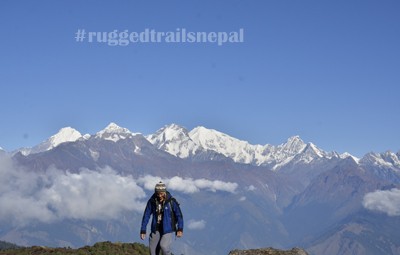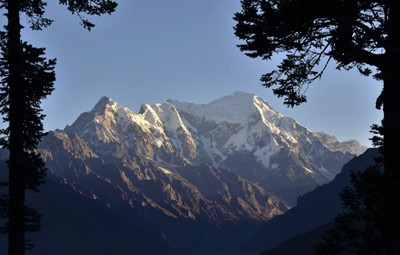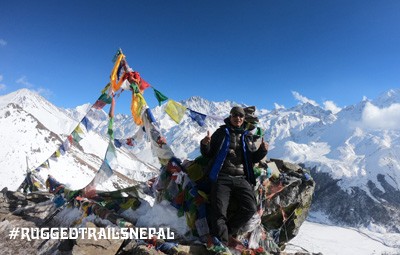The Langtang Valley Trek is a spectacular and accessible 5 to 7-day journey north of Kathmandu, renowned for its breathtaking panoramas of the Langtang Himalaya, including Langtang Lirung, within the pristine Langtang National Park. This moderate trek starts with a scenic drive to Syabrubesi and ascends through lush rhododendron forests and traditional Tamang villages to the cultural hub of Kyanjin Gompa (3,870m), offering encounters with rich Buddhist heritage, diverse flora and fauna, and optional climbs to Tserko Ri for unforgettable mountain vistas. Perfect for beginners and those seeking a less-crowded alternative to the Everest and Annapurna circuits, it combines dramatic glacial valleys, authentic tea house stays, and deep cultural immersion into a compact and rewarding Himalayan adventure.
Let's celebrate together "Visit Nepal 2026", Get amazing discounts for group travelers!
- Duration10 Days
- Price from$552/ person
- Difficulty LevelModerate
- Max Altitude5,050 (16,568 ft)
Welcome to the land of the Snow Leopard and the Red Panda. The Langtang Valley Trek is a popular trekking route in the Nepal Langtang region, north of Kathmandu. It is a fantastic trip that offers spectacular views of the Langtang Himalayan range, the flora and fauna of Langtang National Park, and the rich culture and Tamang ethnic traditions. Mountaineers argue that the Langtang Valley is really worth seeing, and the views are gigantic. The trekking consists of several ascents and descents through the lush forests.
Kyanjin Gompa is the last point of the Langtang Valley Trek. The trekking begins in Syabrubesi, which is located around a 7-8 hour drive from Kathmandu. Heading through the Langtang National Park and crossing the various Tamang villages like Rimche and Lama Hotel, the trek reaches the Langtang Valley. The trek mostly follows the Langtang Khola River. The settlement is similar to the Tibetan terrain and has a unique lifestyle. The people are innocent and friendly. The cultural hospitality of the local people is wonderful during the trek to Langtang Valley. Then the Langtang Valley route heads towards the Kyanjin Gompa (3870m) via the cheese factory. Langtang Valley Trek offers breathtaking Himalayan scenery of Langtang Lirung, Ganesh Himal, Lamjung Himal, Naya-Kang, Lantang-RI, Langshisa, Tserku-RI, Langtang Glacier, and other views. There is diverse flora and fauna on this trekking route. Oaks, pines, rhododendrons, maples in the flora, wild boar, red pandas, ghoral, rhesus monkeys, snow leopards, etc. are the wild animals found on this trekking trail.
Highlights of Langtang Valley Trek
- Trekking through the Langtang Valley, also known as the ‘valley of glaciers’, and encountering beautiful landscapes and natural beauty.
- Climbing Tserko Ri for its stunning scenic views, including a panoramic view of the Langtang ranges.
- Viewing snow-capped mountains such as Langtang Ri, Langtang, Langsisa, and Ganjala Peak.
- Experiencing Tibetan Buddhist culture and life firsthand, including traditional villages, monasteries, and culture.
- Walking through spectacular rhododendron forests, which are in full bloom during the spring season,.
- Collecting blessings at old Buddhist shrines such as Langtang Gompa and Kyanjing Gompa.
- Staying in interesting teahouses along the route offers a unique experience of local culture and food.
- Langtang valley trek is one of the lesser-known treks in Nepal and offers a chance to explore the less-crowded trail
Passing through the hospitable Tamang villages, natural hot springs,s and surprising landscapes throughout the Langtang Valley trek makes the trip exciting. Rugged Trails Nepal welcomes you to trek with our experienced mountain leaders and the ideal services. We also operate the Langtang Trek on your Langtang Valley Trek itineraries.
Tea House Trek in Nepal with an open mind and a broad heart. "Nitty Gritty"
Teahouses, guest houses, and hotels located along mountain trails provide trekkers with accommodation, meals, and socializing space. After the 2015 earthquake, some of these places have been upgraded to nicer hotels. The accommodation options are typically simple and include twin rooms with shared toilets and bathrooms, but some have attached bathrooms. The toilets are Western-style or squat-style, as are the hot showers. Hot water will be available for an additional fee. The sleeping rooms have beds and blankets, but it is recommended to bring your own sleeping bag as it can get chilly at night. There is no heating in the sleeping rooms. Typically, a stove of some kind heats and uses solar energy to light the dining area of teahouses. Most teahouses have a service to charge devices for a fee. Meals are served at communal tables where trekkers can share their experiences and discuss their journey. The menu options vary, but usually include a variety of food choices. Boiled water is often provided instead of plastic bottles, which is better for the environment, but there is usually a small fee for it. To ensure safe drinking water, it is recommended to bring your own water sterilizing tablets or a life straw.
How long is the Langtang Valley Trek?
The Langtang Trek is a journey that covers a distance of 77 km/48 mi (including Kyanjin Ri Peak). On average, it takes 5-7 days to complete the trek, depending on factors such as trail conditions, weather, and personal pace. The route can be extended by adding side treks, increasing the total distance.
How difficult is the Langtang Valley Trek?
The Langtang Trek is considered to be a moderately difficult trek, and it's perfect for beginners as well. The trail takes you through a beautiful valley, across a river, and into the lap of giant mountains, with the Langtang National Park being a major attraction. The trek is about 62 kilometers north of Kathmandu and can take a week or more to complete. It is important to note that the difficulty level of the hike can vary depending on the trail conditions, weather, and personal fitness level. It is best to be prepared for the trek and be in good physical shape to enjoy the trek.
Do we need to take a domestic flight from Trek to Langtang?
No, it is not necessary to take a domestic flight to trek to the Langtang valley or Langtang region. The trek can be reached by taking a jeep or bus drive from Kathmandu. The journey starts with a drive from Kathmandu to Syabrubesi, which is the starting point of the trek. This will take around 7-8 hours by bus and around 6-7 hours by jeep. The journey by jeep or bus offers great landscapes and views of the Himalayas.

Langtang Valley After Earthquake
I was so amazed to see Langtang valley because it was completely vanished by the Earthquake but now there are many tea houses and life is normal. Chorkar Ri is one the best view point and the Himalayan view is spectacular. I would say to all Go ...
Read thisItinerary
- Day: 1
Arrive in Kathmandu.
- Day: 2
Sightseeing around Kathmandu.
After breakfast proceeds our short guided sightseeing tour at the Swayambhunath Temple. After Swayambhunath temple, we will visit another UNESCO World Heritage sites Patan Durbar Square, and Buddhist shrine (Bouddhanath), which is also one of the largest stupas in the world.
After sightseeing drives back to hotel and briefing of our rest of trip plan. At the same time if you have to buy any trekking gears or things for the rest of the days Guide will help take you to the trekking equipment store in Thamel.
- Day: 3
Kathmandu Drive to Syabrubesi.
- Day: 4
Syabrubeshi to Lama Hotel.
- Day: 5
Lama Hotel to Langtang valley.
- Day: 6
Langtang valley to Kyanjin Gompa.
- Day: 7
Visit Chorkari ri (5050m) and trek back to Lama Hotel.
- Day: 8
Lama hotel trek to Syabrubeshi.
- Day: 9
Drive back to Kathmandu.
- Day: 10
Final departure.
Transferred to the international airport on your flight schedule and if some have extra days in Nepal they can continue with other activities. If any help is needed for further plans feel free to contact rugged trails Nepal team.
What's Included
- Full Board (breakfast, lunch, and dinner) in Trekking
- Accommodation during the trek (local lodge)
- The government registered English-speaking local expert guides and porters.
- Langtang National Park fees, TIMS Card.
- Accommodation in Kathmandu on twin sharing with breakfast
- Guided tour in the city with an expert tour guide.
- Farewell dinner in the city
- equipment and clothing for porters and staff.
- Insurance for all staff and porters.
- Transportation to and from the starting and ending points of the trek (sharing)
- First Aid Kit.
- Langtang Valley Trekking Map
- Salary, allowances, expenses & insurance for all staff, including porters
What’s Excluded
- Nepal visa: Multiple Entrée (30 days): USD 40
- Lunch and dinner during hotel stay in Kathmandu
- Personal gear and clothing (available on hire)
- Tips, any expenses, table drinks, snacks while walking
- Personal insurance and medical evacuation in case of emergency
- Service other than those mentioned above
- Expenses incurred due to accidents, landslides, strikes, political unrest, etc.
- International airfare and airport taxes.
- Items of personal nature such as alcoholic drinks, cold drinks, laundry, and mineral water
- Entrance fees during sightseeing in the city.
Useful Information
Food and Drink on the Langtang Valley Trek
The Langtang Valley trek is a secluded trail, which may come as a surprise given its proximity to Kathmandu. As a result, the teahouses along the trail offer a more limited menu compared to those on busier trails. However, there are still several options available, such as Nepali Dal Bhat, noodles, fried rice, some continental meals, and soup. Breakfast options include eggs, toast, Tibetan bread, and porridge. Tea, soft drinks, and possibly coffee and alcohol are also available at the teahouses. It is worth noting that drinking alcohol should be done in moderation, as it can have negative effects at high altitudes.
Is there electricity and hot showers on this trek?
Hot showers are available but have an additional cost, and electricity is also available at a cost. It is recommended to bring your own power bank or a portable solar charger to avoid the charges.
Do I need to buy travel insurance for the Langtang Trek? Any suggestion?
Before starting the Langtang trek, it is crucial to have adequate travel insurance because the trekking agency's insurance does not cover it. Make sure to have insurance that covers trekking at high altitudes and the cost of helicopter rescue in an emergency. Check World Nomads for Nepal Travel Insurance
Safety in Nepal and while trekking the Langtang Valley
In summary, Nepal is generally considered safe for tourists, but it's important to stay informed about current events and avoid any protests. Keep valuables hidden and think about storing them in a locker that a trekking company will provide. Follow your guide's instructions in the event of a natural disaster and immediately inform them if you feel unwell. The village of Langtang, which was affected by the 2015 earthquake, is currently being rebuilt, and trekkers will be lodging in a nearby community. If you haven't watched AfterShock on Netflix, then get some idea about it.
How does the trek across the Langtang Valley proceed each day?
A typical day on the Langtang Valley trek begins early in the morning, usually around 6 or 7 a.m. After breakfast in the teahouse dining room where you spent the night, you and your guide will set off for the day's hike. Along the way, your guide will point out and provide context for various sights, such as Buddhist shrines, mani stones (rocks with carved Buddhist inscriptions), and prayer flags. They will also discuss the mountain names and any special meanings they hold for the local people.
You will take breaks throughout the day to rest and have snacks. Lunch is typically consumed at small tea shops along the route. When you reach your destination for the night, such as Kyanjin Gompa, you have the option to have both lunch and dinner there. You are expected to place your order from the menu upon checking into the teahouse or trekking lodge to give the staff time to prepare your meals.
After dinner, there is usually ample time to interact with other hikers and get information from your guide about the next day's itinerary. Bedtime is usually early because the day begins early, and hiking can be exhausting.
Similar to Your Taste
Great Company Excellent guide
- Cliff Threadgold, New ZealandThank you. It was a great trip, and Dipak was an excellent choice for a guide. I look forward to catching up over the weekend, and definitely I will Rugged Trails Nepal (Nirajan) for everyone.
Experience Nepal
- Nerea, SpainIn September, I had the great opportunity to travel to Nepal and the great luck that this company will organize my trip. I did a Tamang Heritage Langtang trek, in which everything was excellent, from the transfer to the guide, porter ... all excellent! and of course with a personalized and unique treatment. After the trek, I was in the city with city routes, also an excellent treatment. In summary a serious company, responsible and with a personalized and unique treatment.
Check Nerea Nepal experiences which she shared with Rugged Trails Nepal; Solo Female Traveler in Nepal




